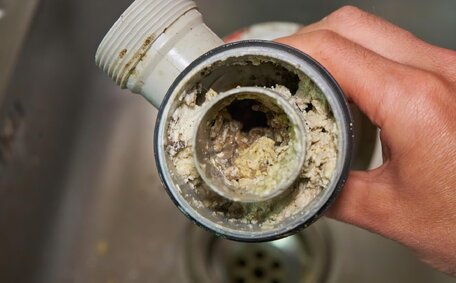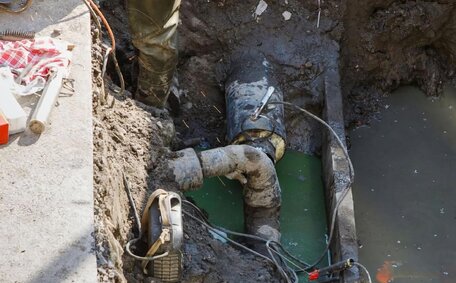Introduction to Gas Line Installation
Installing a gas line boosts appliance efficiency for stoves, ovens, and heaters. Homeowners favour natural gas for its efficiency and clean burn, making it perfect for cooking, heating, and year-round indoor comfort.
North Mead Plumbing, with vast experience and a licence, offers gas connection solutions to North Mead residents in Sydney. With our expertise in gas services, we can assist with complete new installation gas procedures as well as gas line repairs to ensure your system is properly sized, safely installed, and up to code. This introduction outlines the steps involved in a comprehensive gas line installation repair project.
Typical Steps for Installing a Gas Line
Installing a gas service line is a complex process that requires expertise. Key steps for installing an underground gas line include:
- Planning & Permits - A skilled gas fitter assesses your property to determine the best routes, outlet placements, and pipe sizes for your needs, and obtains the required permits.
- Trenching - For safety, trenches roughly 45 cm deep are dug to bury underground natural gas lines properly.
- Piping - Steel and polyethylene pipes are preferred for their suitability to various gas installation requirements. The pipes are secured and assembled through the trenches, with valves installed at key junctures, ensuring that any gas line repair can be efficiently conducted if necessary.
- Pressure Testing - To confirm safety, completed gas pipes are tested with pressurised air or nitrogen to detect any leaks before connection.
- Gas Meter Connection - The gas fitter performs significant tasks in the gas distribution process to affix the meter to your piping system, thus consolidating it into the extensive Australian gas networks.
- Appliance Connections - Our professionals execute heater installations and connect your gas lines to individual appliances, integrating hot water systems with precision, utilising fuel supply shutoff valves branching from the main piping.
- System Verification - A critical step entails thoroughly testing all arranged connections, valves, venting, and extensions with leak detectors to prevent any leak on your property, ensuring a safe connection request fulfillment.
Your gas connection strategy may vary due to factors such as house layout, local codes, and the availability of natural gas in your area. But these steps are fundamental to the process of making gas available your home or business premises. Our qualified gas licenced North Mead Plumbing specialists handle any necessary repair gas tasks, ensuring your system operates safely and caters to your requirements efficiently.
Planning and Preparation
Before trenching and laying pipes, detailed planning and preparation are vital for gas line installation. Thorough planning facilitates strict safety adherence, essential for protecting your home or business:
- Your meter location for gas service is strategically chosen for easy access and connections while accounting for gas connection fees, reading requirements, and ongoing maintenance.
- Required permits are secured in advance from local authorities.
- Safety protocols are determined regarding pipe routing and minimum distances from structures.
- Timeframes are established so homeowners know what to expect.
Australian standards mandate that gas pipes be at least 3 feet away from building openings. We prepare detailed pipe routing plans for review and approval by the necessary authorities. This facilitates ensuring your gas line connected to the system swiftly, with permits typically secured in 5-10 business days.
As gas line installation can disrupt road access and utilities for 1-5 days, comprehensive planning is critical. Our North Mead Plumbing crew manages comprehensive coordination, so homeowners can prepare rightly for their needs—contact us for any assistance during this phase.
Excavation and Trenching
Trenching demands meticulous preparation to correctly install gas lines in trenches around 45 cm deep. The route and depth adhere to safety standards and consider any existing gas infrastructure:
- Prevent accidental pipe damage from aboveground activity
- Allow proper gradient and drainage
- Keep pipes accessible for maintenance
- Ensure suitable distance from existing utility lines
Trenching and backfilling afterwards play a crucial role in the overall timeline for property natural gas line installations, which is why we manage these tasks with utmost care. The duration of the process depends on site-specific factors:
- Soil conditions and obstacles
- Trench length required on the property
- Weather constraints
- Crew size
Our specialists efficiently and precisely lay gas pipes using excavators and backhoes, guaranteeing a dependable gas supply. We may also need to bore small holes under driveways, gardens and structures rather than trench across them. Careful planning optimises this while working around potential access issues trenching creates temporarily.
Running Piping and Connections
The process to install gas lines running from the supply point to the meter, and further throughout the property, calls for specialised expertise. There are a few key steps involved:
- Assembling Pipes - Steel and polyethylene junctions form a seamless gas line meter system. The pipes are properly aligned, assembled and joined using equipment like pipe cutters and fusion machines for leak-proof connections.
- A skilled fitter can anchor the piping runs at intervals to structures using clamps and brackets for support and stability.
- Valves - Shut-off valves are installed, enabling you to turn gas on or off at the end points of pipe runs as well as at equipment connections for safety.
- Venting - Vents are essential for the discharge of gases and mitigating hazards in locations where there no natural gas line dilution processes. Vent caps on the piping prevent outdoor elements from penetrating.
- Testing - The required pressurised tests check for leaks at pipe joints using detectors before the gas connection is finalised.
- Connections - Individual appliances are hooked up to the piping via fuel shutoff valves, sediment traps, connectors and more.
Our experienced North Mead Plumbing professionals install gas lines that are safe and compliant with all regulations. We take care to size pipes appropriately, determine optimal routing, provide stable mounting, install protective features, and perform thorough system verification before use.
Safety Standards and Precautions
A licensed gas fitter must strictly adhere to safety protocols to safely install and maintain gas lines and prevent hazardous incidents.
As per Australian standards:
- Gas pipes must be located at least 3 feet away from any building openings like windows or doors
- Gas metres must remain unobstructed and safely accessible for reading, maintenance, and emergency shut-off
- Adequate venting must facilitate the dissipation of leaked gases
- All piping connections must be sealed, with no loose fittings or cracked seals
- Valves should enable individual appliance isolation and complete system shutdown
Our North Mead Plumbing gas fitters adhere to all safety protocols during gas system installations and maintenance:
- Conducting rigorous leak checks with gas detectors
- Ensuring adequate mounting and protection of external pipes
- Installing crucial emergency gas shut-off valves
- Providing essential advice to ensure your family’s safety concerning gas usage and leak prevention
We also provide continuous gas service inspections and maintenance to ensure safe system operation long after the initial installation.
Inspections and Certification
Before the gas line installation can be officially completed and certified, rigorous inspections occur by authorities. This crucial final step verifies that all work pertaining to getting gas connectivity meets the latest safety standards and regulations.
During inspections, authorities meticulously examine your gas system:
- Pipe locations and minimum distances from buildings
- Venting provisions
- Adequate mounting, protection and sealing of external pipes
- Correct pressure testing and leak detection
- Unobstructed gas metre access
- Compliant appliance connection fittings
A completion certificate for your gas service is issued only after your gas fitter confirms full compliance. This legally permits activating the gas line installed to initiate supply into the property.
Industriously, our team at North Mead Plumbing takes steps to make sure gas lines are certified as safe following stringent protocols. We also take care of all inspection arrangements on our client’s behalf for fastest completion. Reach out to learn more about gas line installation and the steps we take to deliver works meeting all codes.
Factors Influencing Timeframes
Several crucial factors determine the timeline needed for complete gas installation projects:
- Water Heater Approvals - Securing permits for your water heater from local authorities can take anywhere from 5-15 business days depending on department workloads.
- Scope & Complexity - The size of the gas line system, need for branched piping to multiple appliances, and technical constraints influence install times.
- Excavation Issues - Challenging soil conditions, buried utilities, trees and hardscaping can complicate trenching efforts.
- Materials Availability - Specialised pipes and parts may require ordering and delivery which adds days.
- Crew Size - Larger experienced crews work faster to complete tasks like trenching, piping, testing in sequence.
- External Factors - Weather delays, access constraints, coordination with supply authorities etc. can also impact projects.
Typically, addressing concerns like 'do I qualify for gas service?' and how long full gas line installation for a typical home takes, we can help you understand that it ranges from 1-5 days depending on the project’s scope. More complex projects with extensive trenching or appliance connections may need additional days. Adequate planning is crucial, and we ensure our clients are well-informed on what to expect for their tailored gas connection installation.
As your licensed gas contractor, North Mead Plumbing provides precise scheduling, ensuring your new home’s gas system is operational as expected. Our experienced teams are dedicated to helping you set up the best gas solutions that are both safe and timely.
DIY vs Professional Installation
DIY gas line installation might seem cost-effective, but without proper training and licensing, it carries considerable safety hazards. There are several key reasons to hire a professional gas fitting contractor like North Mead Plumbing instead:
- Expertise - Professional gas fitters are versed in the technicalities required for safe, code-compliant, leak-proof installations.
- Compliance - Illegally installed gas systems may not pass inspection or gain certification for legal use.
- Risks - Faulty DIY-installed gas lines can cause leaks or failure, which are detectable by a distinctive rotten egg smell, potentially leading to fires, explosions, and carbon monoxide poisoning.
- Timeliness - DIY approaches do gas connections an injustice and often drag out for weeks or months, whereas pro gas fitters work efficiently.
- Liability - You may be legally and financially liable for any dangerous incidents arising from unlicensed gas works.
By choosing North Mead Plumbing, you avoid these risks and gain access to our comprehensive services, including insured installations with top-quality fittings under warranty and expert project management. Our gas line installation specialists skillfully handle your project from permit acquisition to certification, minimising disruption and risk. Contact us to discuss specifics for your property.
Cost Considerations
The costs of installing or connecting a gas line to your property, including materials, permits, and labour, are elements that our team can provide detailed quotes for. Factors that affect gas line installation costs include:
- Line Length - Longer trenching distances for reaching your gas appliance mean more piping is required. Costs typically range from $65-$325 per metre depending on factors such as excavation complexity.
- Appliance Connections - Hooking up gas appliances like stoves or water heaters via branch lines off the main pipe runs adds to material and labour costs.
- Permits & Inspections - For these essential components of the gas connection process, you’ll need to account for the potential costs for budgeting permits, which typically range from $100-$500+ depending on your service provider and locality.
- Pipe Size - Larger diameter pipes needed to meet demand levels are more expensive.
- Extra Equipment - Specialised parts like metres, valves, vents also contribute to costs.
Given the complexity and wondering how much does connecting gas to your property cost, the task can be daunting, but with our expertise, we can help provide a detailed assessment. Obtaining a detailed quote from a licenced professional like North Mead Plumbing is highly recommended. This allows due consideration of your specific setup, gas usage needs and other influencing factors in framing an accurate estimate.
As Sydney gas fitting specialists, we are happy to provide free, no-obligation quotes outlining everything involved in your gas line installation project, eliminating surprises down the line. Contact us or call 1300 349 338 to get started.






